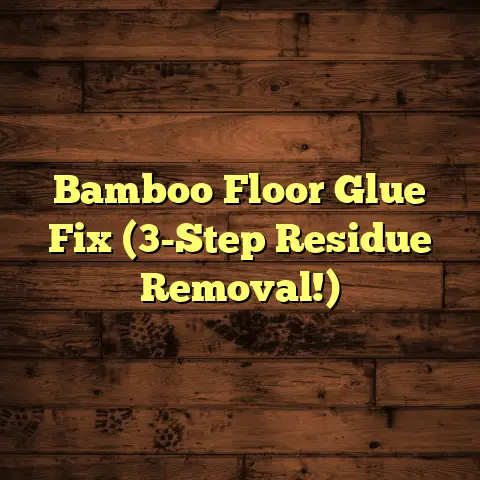Water Under Tile? (10 Urgent Leak Checks!)
Let’s dive into a topic that can send shivers down any homeowner’s spine: water under tile.
I’m talking about that sinking feeling when you step onto your beautiful tiled floor and hear that dreaded “squish.”
Imagine this: You’ve just returned home from a long day at work, ready to unwind in the comfort of your living room.
The aroma of your favorite dinner wafts through the air as you set down your bag and walk across the beautifully tiled floor.
But suddenly, you notice something feels off. With each step, a distinct squish resonates beneath your feet, an unsettling sound that sends a jolt through your senses.
You kneel down, placing your hand on the cool tiles, and your heart sinks—the surface feels oddly damp.
As the realization dawns on you, panic begins to rise. Water under the tile?
How long has it been there? Is it a minor issue, or could it escalate into something catastrophic?
The tiles, once a source of pride in your home, now feel like a ticking time bomb.
You know you have to act fast. Ignoring the problem could lead to mold growth, structural damage, and skyrocketing repair costs.
You feel a sense of urgency wash over you as you begin to formulate a plan to check for leaks.
I’ve seen this scenario play out countless times in my years as a flooring contractor, and I can tell you, ignoring it is not an option.
Water lurking beneath your tiles can lead to serious problems like mold, structural damage, and costly repairs.
Don’t worry, I’m here to help you navigate this sticky situation.
Together, we’ll explore 10 urgent leak checks you can perform to identify the source of the problem and take action before it’s too late.
1. Understanding the Problem: What Causes Water Under Tiles?
First things first, let’s understand why water might be chilling beneath your tiles in the first place.
It’s not just some random act of nature; there’s usually a culprit involved.
Here are a few common causes I’ve encountered:
-
Plumbing Leaks: This is the big one. A leaky pipe hidden behind a wall or under the floor is a prime suspect. Even a small drip can accumulate over time and seep through grout lines.
-
Condensation: In humid environments, condensation can form under tiles, especially in areas like bathrooms or near exterior walls. Think of it like a cold glass of water on a hot day.
-
Improper Installation: A poorly installed tile floor is an open invitation for water damage. If the subfloor wasn’t properly prepared or the tiles weren’t sealed correctly, water can easily penetrate.
-
Spills and Accidents: Let’s face it, accidents happen. A spilled drink, an overflowing bathtub, or a leaky appliance can all contribute to water accumulation.
-
Groundwater Seepage: In some cases, water can seep up through the foundation of your home, especially if you have a basement or slab-on-grade foundation.
Now, let’s talk materials. Tile itself is generally waterproof, but the grout and sealant are not.
These porous materials can absorb water, allowing it to seep beneath the tiles.
Common materials used in tile flooring include:
-
Ceramic Tile: Durable and water-resistant but can crack under heavy impact.
-
Porcelain Tile: Even more water-resistant than ceramic, making it a popular choice for bathrooms and kitchens.
-
Stone Tile (e.g., Marble, Granite): Beautiful and durable but can be porous and require sealing.
-
Grout: Fills the spaces between tiles and is prone to absorbing water if not properly sealed.
-
Sealant: Applied to grout lines and tile surfaces to create a waterproof barrier.
These materials interact with moisture in different ways. For example, stone tiles like marble are naturally porous and can absorb water if not properly sealed.
According to the Marble Institute of America, “All natural stone is porous to some degree, and therefore susceptible to staining.”
This means that even seemingly waterproof materials can be vulnerable if not properly maintained.
2. Visual Inspection of Surface Conditions
Alright, detective, it’s time to put on your Sherlock Holmes hat and start investigating.
The first step is a thorough visual inspection of your tile surface.
I’m talking about getting down on your hands and knees and really looking for clues.
Here’s what to look for:
-
Discoloration: Keep an eye out for any dark spots, stains, or changes in color on the tile or grout. This could indicate water damage or mold growth.
-
Cracked Tiles: Cracks in the tiles can create pathways for water to seep underneath. Even hairline cracks can be problematic.
-
Warping or Buckling: If the tiles are lifting, warping, or buckling, it’s a sign that water has caused the subfloor to swell or the adhesive to fail.
-
Efflorescence: This is a white, powdery substance that can appear on the surface of the tile or grout. It’s caused by mineral salts being drawn to the surface by moisture.
-
Missing or Damaged Grout: Gaps or cracks in the grout lines can allow water to penetrate.
When inspecting, pay close attention to areas that are frequently exposed to water, such as:
- Around toilets and sinks
- Near showers and bathtubs
- In front of dishwashers and washing machines
- Along exterior walls
Don’t just glance; really examine each tile and grout line. Use a flashlight to get a better view in dimly lit areas.
According to the Tile Council of North America, “Regular inspection and maintenance are essential for preserving the beauty and longevity of tile installations.”
3. Listening for Unusual Sounds
Okay, now it’s time to use your ears.
Sometimes, leaks aren’t visible, but they’re definitely audible.
I’m talking about listening for the telltale sounds of water dripping, gurgling, or trickling.
Here’s how to do it:
- Turn off all appliances: Shut off the TV, the dishwasher, the washing machine – anything that could create background noise.
- Find a quiet time: Early morning or late evening is usually best when the house is quiet.
- Listen closely: Place your ear near the tile floor, especially in areas where you suspect a leak.
- Follow the sound: If you hear something, try to pinpoint the source. Is it coming from under the tiles, behind a wall, or from a nearby fixture?
What kind of sounds should you be listening for?
- Dripping: A slow, steady drip can indicate a small leak in a pipe or fixture.
- Gurgling: This could be a sign of water backing up in a drain or a leak in a plumbing vent.
- Trickling: A faint trickling sound could indicate water running along a pipe or under the floor.
- Squishing: Of course, the classic “squish” when you step on a wet spot is a dead giveaway.
Identifying the source of the noise can be tricky, but it’s worth the effort.
Sometimes, the sound will be faint and difficult to hear.
Try using a stethoscope or a length of hose to amplify the sound.
Place one end of the hose near the tile floor and the other end to your ear.
According to the Environmental Protection Agency (EPA), “Even small leaks can waste a significant amount of water over time.”
4. Checking for Dampness with a Moisture Meter
Alright, let’s bring out the big guns!
A moisture meter is a handy tool that can help you detect moisture levels in building materials, including tile floors.
I use these all the time on job sites.
Here’s the lowdown on moisture meters:
- What it is: A device that measures the amount of moisture in a material.
- How it works: It sends an electrical signal through the material and measures the resistance. The higher the moisture content, the lower the resistance.
- Types: There are two main types: pin meters and pinless meters. Pin meters have two or more pins that you insert into the material. Pinless meters use electromagnetic waves to detect moisture without penetrating the surface.
How to use a moisture meter:
- Calibrate the meter: Follow the manufacturer’s instructions to calibrate the meter before use.
- Select the appropriate setting: Choose the setting for the type of material you’re testing (e.g., tile, wood, concrete).
- Take readings: Place the meter on the tile surface and take a reading. Take multiple readings in different areas.
- Compare readings: Compare the readings to a baseline (a dry area of the floor) to identify areas with elevated moisture levels.
What do the readings mean?
- Low readings: Indicate a dry material.
- Moderate readings: May indicate some moisture, but not necessarily a leak.
- High readings: Indicate excessive moisture and a potential leak.
Pin meters can be more accurate, but they can also damage the tile surface.
Pinless meters are less invasive, but they may not be as accurate.
I recommend using a pinless meter first and then using a pin meter in suspicious areas to confirm the readings.
According to the American Society for Testing and Materials (ASTM), “Moisture meters should be calibrated regularly to ensure accurate readings.”
5. Inspecting Plumbing Fixtures and Appliances
Okay, let’s get practical.
The next step is to inspect all nearby plumbing fixtures and appliances for leaks.
I’m talking about sinks, toilets, showers, bathtubs, dishwashers, washing machines – the whole shebang.
Here’s what to look for:
-
Under Sinks: Check the supply lines, drainpipes, and faucet connections for leaks. Look for signs of water stains or corrosion.
-
Around Toilets: Check the base of the toilet for leaks. Look for water stains on the floor or signs of mold growth.
-
Showers and Bathtubs: Check the grout and sealant around the edges of the shower or bathtub. Look for cracks or gaps that could allow water to seep through.
-
Dishwashers: Check the supply line and drain hose for leaks. Look for water stains on the floor or under the dishwasher.
-
Washing Machines: Check the supply lines and drain hose for leaks. Look for water stains on the floor or behind the washing machine.
When inspecting, don’t just look; feel. Run your hand along the pipes and connections to check for moisture.
Use a flashlight to get a better view in dimly lit areas.
If you find a leak, repair it immediately. Even a small drip can cause significant damage over time.
According to the Institute of Inspection, Cleaning and Restoration Certification (IICRC), “Water damage can lead to mold growth within 24 to 48 hours.”
6. Evaluating Grout and Sealant Integrity
Now, let’s talk about grout and sealant.
These materials play a crucial role in protecting your tile floor from moisture.
I can’t stress this enough: if your grout and sealant are compromised, your floor is vulnerable.
Here’s how to evaluate their integrity:
-
Inspect the grout lines: Look for cracks, gaps, or missing grout. Pay close attention to areas that are frequently exposed to water.
-
Test the sealant: Apply a few drops of water to the grout lines and observe how quickly it absorbs. If the water beads up, the sealant is still effective. If the water soaks in, the sealant needs to be reapplied.
-
Check for discoloration: Discolored grout can indicate water damage or mold growth.
-
Look for crumbling or powdery grout: This is a sign that the grout is deteriorating and needs to be replaced.
If you find any problems with your grout or sealant, take action immediately.
You can repair small cracks in the grout with a grout repair kit.
For larger cracks or missing grout, you may need to remove the old grout and apply new grout.
Reapply sealant to the grout lines every 1-2 years, or as needed.
According to the National Tile Contractors Association (NTCA), “Proper grout and sealant maintenance is essential for preventing water damage in tile installations.”
7. Assessing the Subfloor Condition
Okay, things are getting serious.
If you’ve checked everything else and still haven’t found the source of the leak, it’s time to assess the subfloor condition.
This involves lifting a tile (if necessary) to inspect the subfloor for water damage.
Warning: This step can be tricky and may require some DIY skills. If you’re not comfortable lifting a tile, it’s best to call a professional.
Here’s how to do it:
- Choose a tile: Select a tile in an area where you suspect water damage.
- Remove the grout: Use a grout saw or a utility knife to carefully remove the grout around the tile.
- Loosen the tile: Use a chisel and a hammer to gently loosen the tile from the subfloor.
- Lift the tile: Carefully lift the tile from the subfloor.
-
Inspect the subfloor: Look for signs of water damage, such as:
- Discoloration: Dark spots or stains on the subfloor.
- Soft or spongy areas: Areas that feel soft or spongy to the touch.
- Mold growth: Black, green, or white mold growing on the subfloor.
- Rotting wood: Wood that is crumbling or decaying.
If you find any of these signs, it’s a clear indication that water has penetrated the subfloor.
You may need to replace the damaged subfloor before reinstalling the tile.
According to the Resilient Floor Covering Institute (RFCI), “The subfloor must be clean, dry, and level before installing any type of flooring.”
8. Thermal Imaging as a Leak Detection Tool
Alright, let’s get high-tech!
Thermal imaging is a non-invasive technique that can help you identify leaks without tearing up your floor.
I’ve used thermal cameras on several jobs, and they’re incredibly effective.
Here’s the scoop:
- What it is: A technology that uses infrared radiation to create an image of temperature variations.
- How it works: Water absorbs heat, so areas with moisture will appear cooler on a thermal image.
- How to use it: You can rent a thermal camera or hire a professional who specializes in leak detection. Scan the tile floor with the camera and look for areas that appear cooler than the surrounding areas.
Thermal imaging can be particularly useful for finding hidden leaks behind walls or under floors.
It can also help you identify the source of the leak, which can save you time and money on repairs.
According to the American Society of Home Inspectors (ASHI), “Thermal imaging can be a valuable tool for identifying hidden problems in a home.”
9. Reviewing Historical Water Damage
Okay, let’s take a trip down memory lane.
Have you had any past water damage incidents in your home?
A previous leak, a flooded basement, or a leaky roof could all contribute to the current problem.
I always ask my clients about the history of their homes.
Here’s why it’s important to review historical water damage:
- It can help you identify the source of the leak: If you know that you had a leaky pipe in the past, it’s possible that the same pipe is leaking again.
- It can help you assess the extent of the damage: If you know that the leak has been going on for a long time, it’s likely that the damage is more extensive.
- It can help you prevent future problems: By addressing the root cause of the previous water damage, you can prevent similar problems from occurring in the future.
Gather any records you have of past repairs, such as invoices, insurance claims, or inspection reports.
Talk to previous homeowners or neighbors who may have information about the history of the home.
According to the Federal Emergency Management Agency (FEMA), “Understanding the history of your home can help you identify and mitigate potential hazards.”
10. Consulting Professionals: When to Call a Plumber
Alright, let’s be honest.
Sometimes, DIY is not enough. If you’ve tried all of these leak checks and you’re still stumped, it’s time to call in the experts.
I know it can be tempting to try to fix the problem yourself, but in some cases, it’s better to leave it to the professionals.
Here’s when to call a plumber:
- Extensive Damage: If the water damage is extensive, such as warped floors, mold growth, or structural damage, it’s best to call a plumber.
- Persistent Leaks: If you can’t identify the source of the leak or the leak keeps coming back, it’s time to call a plumber.
- Complex Plumbing Systems: If you have a complex plumbing system or you’re not comfortable working with plumbing, it’s best to call a plumber.
- Hidden Leaks: If you suspect a hidden leak behind a wall or under the floor, it’s best to call a plumber who has specialized equipment for leak detection.
A professional plumber can diagnose the problem, repair the leak, and prevent further damage.
According to the Plumbing-Heating-Cooling Contractors Association (PHCC), “Hiring a licensed plumber ensures that the work is done safely and according to code.”
Conclusion: Taking Action and Next Steps
So, there you have it: 10 urgent leak checks you can perform to identify water under your tile.
I know it can be overwhelming, but remember, taking action is key.
Don’t ignore the problem and hope it goes away. Water damage can escalate quickly and lead to serious problems.
Here’s what you should do next:
- Perform the leak checks: Follow the steps outlined in this article to identify the source of the leak.
- Repair the leak: If you find a leak, repair it immediately.
- Dry the area: Dry the affected area thoroughly to prevent mold growth.
- Monitor the situation: Keep an eye on the area to make sure the leak doesn’t come back.
- Call a professional: If you’re not comfortable repairing the leak yourself or if the damage is extensive, call a professional plumber.
Remember, your home is your biggest investment.
Protect it by taking proactive steps to identify and resolve water damage issues.
By following these tips, you can keep your home safe, dry, and comfortable for years to come.
Good luck, and happy leak hunting!





